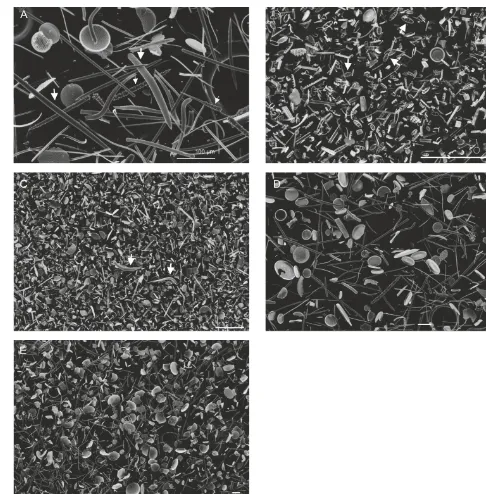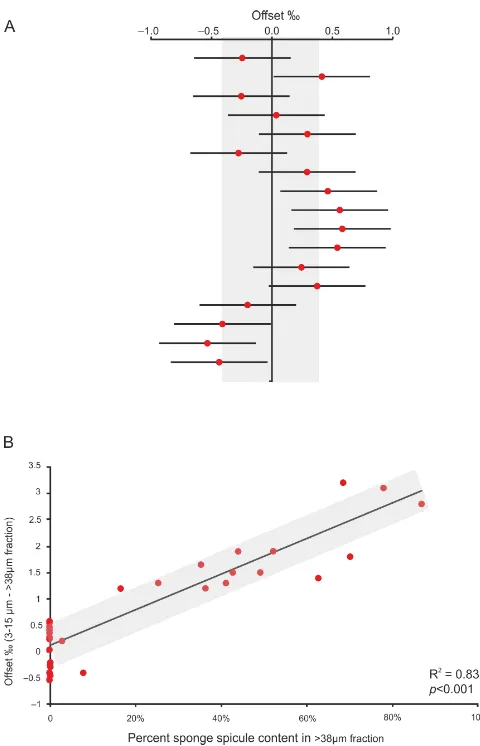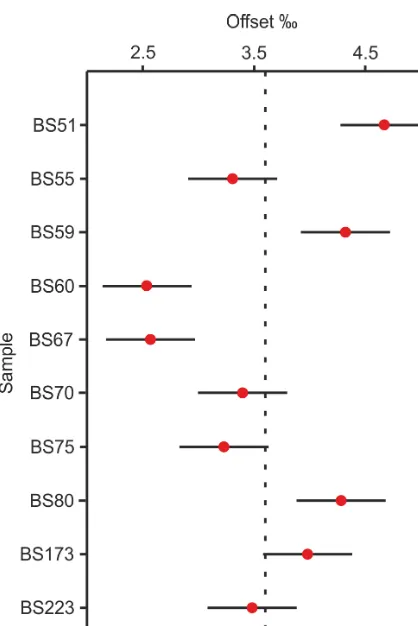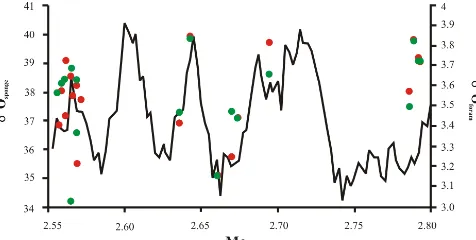www.clim-past.net/10/1837/2014/ doi:10.5194/cp-10-1837-2014
© Author(s) 2014. CC Attribution 3.0 License.
Pliocene diatom and sponge spicule oxygen isotope ratios from the
Bering Sea: isotopic offsets and future directions
A. M. Snelling1, G. E. A. Swann2, J. Pike3, and M. J. Leng1,2
1NERC Isotope Geosciences Facilities, British Geological Survey, Keyworth, Nottingham NG12 5GG, UK 2School of Geography University of Nottingham, University Park, Nottingham NG7 2RD, UK
3School of Earth and Ocean Sciences, Cardiff University, Main Building, Park Place, Cardiff CF10 3AT, UK
Correspondence to: A. M. Snelling (asnel@bgs.ac.uk)
Received: 2 April 2014 – Published in Clim. Past Discuss.: 12 May 2014
Revised: 6 August 2014 – Accepted: 10 September 2014 – Published: 16 October 2014
Abstract. Oxygen isotope analyses of different size frac-tions of Pliocene diatoms (δ18Odiatom) from the Bering Sea
show no evidence of an isotope offset and support the use of bulk diatom species samples for palaeoceanographic re-constructions. Additional samples containing concentrations of sponge spicules produce δ18O values several per mille (‰) lower than δ18Odiatom with a calculated mean offset
of 3.9‰±1.5. This difference is significantly greater than modern-day variations in water δ18O through the regional water column. Despite the potential for oxygen isotope dis-equilibrium within δ18Osponge, there appears to be some
similarity between δ18Osponge and a global stacked benthic
δ18Oforamrecord. This highlights the potential forδ18Osponge
in palaeoenvironmental research at sites where carbonates are not readily preserved.
1 Introduction
The use of oxygen isotopes in palaeoenvironmental research is well documented for both lacustrine and marine envi-ronments, predominantly from carbonate fossils, but more recently from siliceous microfossils (Emiliani, 1955; Dup-lessy et al., 1988; Leng and Marshall, 2004; Lisiecki and Raymo, 2007). Of the latter, diatoms (unicellular algae with a siliceous skeleton; class Bacillariophyceae) are most widely used for oxygen isotope analysis with numerous studies showing how changes in the oxygen isotope ratio of di-atom silica (δ18Odiatom) reflect changes in temperature and
theδ18O of ambient water (δ18Owater) (Shemesh et al., 1992;
Swann and Leng, 2009). The majority of this work has also
shown that there are few, or no, intra- or inter-species iso-tope offsets in diatoms (e.g. Shemesh et al., 1995; Schmidt et al., 2001; Moschen et al., 2005; Dodd and Sharp, 2010), although Swann et al. (2007, 2008) have shown offsets of up to 3.5‰ between different size fractions of Pliocene-and Quaternary-age diatoms from the subarctic North Pacific Ocean.
Another form of biogenic silica commonly found in sedi-ments is siliceous sponge spicules (structural elesedi-ments which support the skeleton of the animal; phylum Porifera, classes Demospongiae and Hexactinellida). Sponge spicules come in a variety of shapes and sizes, ranging from micrometres to metres long (Uziz et al., 2003; Jochum et al., 2012), and are often seen as needle-like structures with a hollow central canal (axial canal) (Müller et al., 2007). The crystalline na-ture of the sponge spicule is similar to that of diatoms (Sand-ford, 2003); however, the processes involved in their synthe-sis are different. Diatom frustules are formed from an or-ganic template onto which a supersaturated solution of silicic acid is deposited, supplemented by passive diffusion across the cell membrane (Thamatrakoln and Hildebrand, 2008), whereas sponge spicules are formed in an enzymatic way, using silicateins, within the sponge organism (Maldonado et al., 2011; Wang et al., 2012). Additionally, diatoms live in the photic zone of the water column whereas sponges are entirely benthic organisms, so the two groups of organisms reflect environmental conditions in different parts of the wa-ter column. The use of oxygen isotope analysis of sponge spicules (δ18Osponge) is rare, and those studies that have been
Figure 1. Location of IODP Site U1341 in the Bering Sea
(Expedi-tion 323 Scientists, 2010).
although some studies show clear trends inδ18O (Matheney and Knauth, 1989; Matteuzzo et al., 2013).
In this study we analyse Pliocene-age biogenic silica from the Bering Sea (2.8–2.6 Ma) to assess (1) whether oxygen isotopic offsets exist between different diatom size fractions and (2) whether siliceous sponges can be used as a tracer of bottom water conditions. Answers to these questions will (1) resolve current uncertainty regarding the palaeoenvironmen-tal potential forδ18Odiatomin Pliocene/early Quaternary
sed-iment samples comprised of bulk diatom species and (2) de-termine whetherδ18Ospongecan be used to produce
comple-mentary benthic δ18O records alongside planktonic records ofδ18Odiatom.
2 Materials and methods
The Bering Sea is a large marginal sea (Hood, 1983; Takahashi, 2005) and, due to its semi-isolated nature, is highly sensitive to both environmental and climatic change (Takahashi et al., 2011). This study uses samples from IODP (International Ocean Discovery Program) Site U1341 (54◦2.00N, 179◦0.50E), which is located in the southern part of the Bering Sea, on the western flank of Bowers Ridge at a water depth of c. 2140 m (Fig. 1) (Expedition 323 Sci-entists, 2010). The age model for IODP Site U1341 is de-rived from the orbital tuning of Uk37records against the LR04 stacked benthicδ18O record (G. Bartoli, personal communi-cation, 2013). Over the analysed interval, 2.8–2.5 Ma, sedi-ment samples are dominated by diatom ooze (with high taxo-nomic diversity and good frustule preservation) and a variety of sponge spicules, which are abundant at this time and tend to be associated with more fragmented diatoms (Onodera et al., 2012; Aiello and Ravelo, 2012).
Figure 2: Examples of sample composition from SEM images: A: examples of sponge spicules from the >38 µm fraction of sample BS77 >38 µm highlighted by arrows; B; An example of the composition of the smaller size fraction with an abundance of Neodenticulata seminae and Neodenticulata koizumii indicated by arrows, BS77 3-15 µm; C: An example of the smaller size fraction with fragments of larger frustules as well as Proboscia spp (incicated). Thalassionema spp. and Thalassiothrix spp. BS48 3-15 µm; D: Detailed view of the >38 µm fraction showing the range of diatoms,BS77 >38 µm; E: Overview of the >38 µm fraction with examples of Coccinodiscusmarginatus, Actinocyclus spp., Proboscia spp.
Thalassionema spp. and Thalassiothrix spp. BS242 >38. All scale bars = 100 µm (See supplementary table for sample depths).
1 1
2 3 4 5 6 7 8 9 10
1
Figure 2. Examples of sample composition from SEM images: (a)
examples of sponge spicules from the>38 µm fraction of sam-ple BS77>38 µm highlighted by arrows; (b) an example of the composition of the smaller size fraction with an abundance of
Neo-denticula seminae and NeoNeo-denticula koizumii indicated by arrows,
BS77 3–15 µm; (c) an example of the smaller size fraction with fragments of larger frustules as well as Proboscia spp. (indicated),
Thalassionema spp. and Thalassiothrix spp. BS48 3–15 µm; (d)
de-tailed view of the>38 µm fraction showing the range of diatoms, BS77>38 µm; and (e) overview of the>38 µm fraction with ex-amples of Coscinodiscus marginatus, Actinocyclus spp., Proboscia spp. Thalassionema spp. and Thalassiothrix spp. BS242>38. All scale bars=100 µm (see Supplement Table S1 for sample depths).
[image:2.612.46.288.65.246.2]Figure 3. (a) The offset between the >38 µm and the 3–15 µm fractions where no/negligible sponge spicules are present. They axis represents sample points, not to scale. Shaded area represents ±0.4 ‰ mean offset, and horizontal error bars for each point rep-resent the ±0.4 ‰ analytical reproducibility. (b) The relationship between the sponge content (area ratio) of the>38 µm fraction and the offset between theδ18O of the diatom 3–15 µm fraction and the mixed>38 µm fraction.
a Finnigan MAT 253.δ18O values were converted to the Vi-enna Standard Mean Ocean Water scale using the NERC Iso-tope Geosciences Laboratory within-run laboratory diatom standard BFCmodcalibrated against NBS28. This method has
been verified through an inter-laboratory calibration exercise (Chapligin et al., 2011) with replicate analyses of sample ma-terial from this current study indicating an analytical repro-ducibility (mean difference) of 0.4 ‰ (1σ=0.3,n=10).
3 Results
3.1 Sample composition
All analysed samples were free of mineral and organic mat-ter contamination, as shown by SEM (Fig. 2) and verified by XRF analyses, with aluminium concentrations in the range of 0.23–0.40 % (typical fossil diatom Al concentrations c. 0.30 wt %; Swann, 2010). Both percent area and biovolume were used to produce relative estimates of the ratio of diatom to sponge in the>38 µm fraction; however, neither of the methods are without error nor do they take into account the voids present in both sponges and diatoms. However in or-der to account for the 3-dimensional aspect of both, we have where possible calculated the biovolume. Sponge spicules were predominantly found in samples from the>38 µm frac-tion, constituting 0–87 % by area ratio (0–92 %, biovolume) of the biogenic silica assemblage, the rest made up by di-atoms (Table S1). The 3–15 µm fraction is comprised al-most entirely of diatom (>99 %), with negligible amounts of sponge spicules (≤1 %), except in nine samples where sponge spicules comprise between 2 and 21 % (area ratio, biovolume not calculated) of the 3–15 µm fraction. These nine samples were used only for comparison to the global stacked benthicδ18Oforamrecord (Lisiecki and Raymo, 2005)
due to the mixed nature of both size fractions. The diatom composition of the>38 µm fraction is dominated by
Coscin-odiscus marginatus, Actinocyclus spp., Proboscia spp. Tha-lassionema spp. and Thalassiothrix spp. The 3–15µm
frac-tion is composed of either fragments of larger frustules or an abundance of Neodenticula seminae and Neodenticula
Koizumii species.
3.2 Diatom and spongeδ18O
Comparison betweenδ18Odiatom from the >38 µm and 3–
[image:3.612.45.285.62.435.2]Figure 4. The offset betweenδ18Odiatom(from the 3–15 µm frac-tion) andδ18O∗sponge (mass balanced value for the>38 µm frac-tion). The horizontal error bars for each point represent the±0.4 ‰ analytical reproducibility. The mean offset (3.0 ‰) is shown by the dashed line.
the relative abundance of siliceous sponge material in the >38 µm fraction, with increased siliceous sponge content leading to lowerδ18O values (Fig. 3b) (Table S1).
It was not possible to acquire a pure sponge sample from the sediment material. In order to assess whether the offset between δ18Odiatom andδ18Osponge is constant over time, a
δ18O value for a pure sponge spicule sample (δ18O∗sponge) was calculated by mass balancing using the relative biovol-ume of sponge spicules identified in the>38 µm fraction and
aδ18Odiatomvalue obtained from the corresponding
diatom-rich 3–15 µm fraction (Table S1). This approach assumes that there is no δ18Odiatom isotope offset between the two size
fractions (see Discussion). If we consider only those sam-ples where the relative abundance of diatoms is less than 60 % of the mixed >38 µm fraction (i.e. where there is a significant proportion of sponge present to minimise the er-rors from estimating the relative diatom and sponge spicule content), then modelled values ofδ18O∗spongeare found to be between 1.9 ‰ and 3.6 ‰ lower thanδ18Odiatom(mean
dif-ference=3.0‰, 1σ=0.6,n=8) (Fig. 4). Despite the offset betweenδ18Odiatom andδ18Osponge varying by>1.5‰ and
the small number of samples studied, the general trend of the
δ18Odiatomandδ18O∗spongerecords are similar over the
anal-ysed time (R2=0.60,p <0.05).
4 Discussion
Comparisons ofδ18Odiatom between different size fractions
of Pliocene Bering Sea diatom samples containing a mix-ture of species show minimal, within 1σanalytical error, iso-tope offsets. This implies that bulk species samples from dif-ferent size fractions can be used forδ18Odiatom analysis on
Pliocene and early-Quaternary deposits from this site. Pre-vious work in the North Pacific (ODP Site 882) has shown offsets inδ18Odiatom of up to 3.5‰ between different size
fractions (Swann et al., 2007, 2008), each containing a mix-ture of species. The mechanisms governing these offsets in size fractions of >75 µm are still unresolved, but may be connected with growth effects associated with larger diatoms (Schmidt at al., 2001). Whilst a recent study has identified offsets of up to 4.2 ‰ between different diatom taxa in sed-iments from the Antarctic coastal margin, this is linked to their habitat within the vertical water column rather than an inter-species effect related to different fractionation in indi-vidual taxa (Swann et al., 2013). A similar scenario cannot occur here in the Bering Sea as intra-seasonal water column variations inδ18O vary by less than 0.5 ‰ over a depth of 0–1188 m (Schmidt et al., 1999). Whilst caution should re-main when analysing bulk samples forδ18Odiatom, the lack of
any significant offset in this study between two size fractions points towards the absence of a habitat-, species- or size-related vital/disequilibrium effect in the Bering Sea. There-fore samples from the mixed species, pure diatom, 3–15 µm fraction, can be used in future palaeoenvironmental interpre-tations.
The formation of sponge spicules is a complex process involving both an intracellular phase followed by an extra-cellular phase using two mechanistically independent biosil-ica condensation/deposition processes (Wang et al., 2012). These processes culminate in a hardening of the spicule through the removal of water, and it is thought that this may influence the morphology of the spicule. Sponges are fur-ther complicated by their ability to rapidly regenerate large portions of their body (Maldonado et al., 2011). The oxygen isotope composition of siliceous sponge spicules and their application to palaeoenvironmental reconstructions is rela-tively understudied and undefined. No estimates exist for a δ18Ospongefractionation factor, and there is no indication of
whether fractionation may vary between species. It is also not clear how interchangeable the oxygen within the hydrous layers is within Si–O–Si molecules or howδ18Osponge may
be affected by formation/regeneration processes. The few δ18Ospongestudies that have been carried out on modern
Figure 5.δ18O∗sponge(mass balanced value for the>38 µm frac-tion) plotted through time for area (red circle) and biovolume (green circle) with a global stacked benthicδ18Oforamrecord (solid black line) (Lisiecki and Raymo, 2005).
of any fractionation liable to vary between seasons (Math-eney and Knauth, 1989; Matteuzzo et al., 2013).
Here we have shown thatδ18O∗sponge is consistently lower
than δ18Odiatomand that the difference between planktonic
δ18Odiatom and that benthic δ18O∗sponge can vary between
1.9 ‰ and 3.6 ‰ over the late Pliocene/early Quaternary (Fig. 4). Differences inδ18O between benthic and planktonic organisms are to be expected, but this difference is signifi-cantly greater than the 0.5‰ variation in the water column at the nearest site for which modern-day data exist (53.1◦N, 177.31◦E; Schmidt et al., 1999). Consequently, at the very least, this suggests different δ18O fractionation factors be-tween diatoms and sponges even when taking into account possible late Pliocene/early Quaternary changes in the water column gradient. The question remains of whether long-term changes inδ18Ospongeare tracking bottom water changes. No
benthic foraminiferaδ18O record exists for this site, although the general trend ofδ18O∗spongethrough this interval is com-parable to a global stacked benthicδ18Oforamrecord (Lisiecki
and Raymo, 2005) (Fig. 5). This is only based on a lim-ited number of samples but clearly hints towards the sponge spicules following a predefined trend and therefore poten-tially carrying a palaeoenvironmental signal reflecting bot-tom water changes. However, it should be noted that whereas δ18O∗
spongevaries by 5.8 ‰ over the analysed time frame, the
stacked benthicδ18Oforamalters by only 0.8 ‰. Such
differ-ences are too great to be explained by local changes in bottom water conditions.
Our results suggest that it is most likely that there is some form of non-equilibrium fractionation associated with the precipitation of silica within sponge spicules. This is not a new observation, as Matheney and Knauth (1989) reported variations of c. 2 ‰ between sponge species growing in the same conditions from both Jamaica and Hawaii and Mat-teuzzo et al. (2013) recorded variations of up to 3.6 ‰ from a single species from a lake in Brazil, with the potential for intra-annual variations of over 5 ‰. Whilst these studies
con-clude that sponge spicules are not formed in isotopic equi-librium with the ambient water, our evidence suggests that changes in bottom water conditions are being broadly cap-tured byδ18Osponge. This is despite the presence of multiple
taxa which have the potential to further obscure any environ-mental signal via inter-species variations in the fractionation ofδ18Owater.
5 Conclusions
Here we show that bulk (mixed species) diatom samples from the Bering Sea can be used to investigate the palaeoenviron-ment fromδ18Odiatomwith no discernible size or species
ef-fect. We have also identified that, at this site, sponge spicule silica has a lowerδ18O value and therefore lower fractiona-tion factor than diatom silica. Previous work has suggested that due to kinetic fractionation mechanisms sponges do not fractionate ambient water in isotopic equilibrium, suggesting
δ18Osponge is not a reliable proxy for palaeoenvironmental
reconstructions. However, in this study,δ18O∗sponge appears to follow the trend of the global stacked benthicδ18Oforam
record of Lisiecki and Raymo (2005). We therefore conclude thatδ18Ospongehas the potential to be used in
palaeoenviron-mental research.
The Supplement related to this article is available online at doi:10.5194/cp-10-1837-2014-supplement.
Acknowledgements. We would like to thank Hilary Sloane for
assistance with the sample analysis and Gretta Bartoli for providing information on the age model used in this paper. This work was funded through NERC grant NE/I005889/1.
Edited by: T. Kiefer
References
Aiello, I. W. and Ravelo, C.: Evolution of marine sedimentation in the Bering Sea since the Pliocene, Geosphere, 8, 1231–1253, 2012.
Dodd, J. P. and Sharp, Z. D.: A laser fluorination method for oxy-gen isotope analysis of biooxy-genic silica and a new oxyoxy-gen iso-tope calibration of modern diatoms in freshwater environments, Geochim. Cosmochim. Ac., 74, 1381–1390, 2010.
Duplessy, J.-C., Shackleton, N. J., Fairbanks, R. J., Labeyrie, L. D., Oppo, D., and Kallel, N.: Deepwater source variation during the last climatic cycle and their impact on the global deepwater cir-culation, Paleoceanography 3, 343–360, 1988.
Emiliani, C.: Pleistocene temperatures, J. Geol., 63, 538–578, 1955. Expedition 323 Scientists: Bering Sea paleoceanography: Pliocene-Pleistocene paleoceanography and climate history of the Bering Sea. IODP Prel. Rept., 323, doi:10.2204/iodp.pr.323.2010, 2010. Hillebrand, H., Dürselen, C.-D., Kirschtel, D., Pollingher, U., and Zohary, T.: Biovolume calculation for pelagic and benthic mi-croalgae, J. Phycol., 35, 403–424, 1999.
Hood, D. W.: The Bering Sea, in: Estuaries and Enclosed Seas, edited by: Ketchum, B. H., Elsevier Sci. Pub. Co., 337–373, 1983.
Jochum, K. P., Wang, X., Vennemann, T. W., Sinha, B., and Müller, W. E. G.: Siliceous deep-sea sponge Monorhaphis chuni: A po-tential paleoclimate archive in ancient animals, Chem. Geol., 300/301, 143–151, 2012.
Leng, M. J. and Marshall J. D.: Palaeoclimate interpretation of sta-ble isotope data from lake sediment archives, Quat. Sci. Rev., 23, 811–831, 2004.
Leng, M. J. and Sloane, H. J.: Combined oxygen and silicon isotope analysis of biogenic silica, J. Quat. Sci., 23, 313–319, 2008. Lisiecki, L. E. and Raymo, M. E.: Plio–Pleistocene climate
evolu-tion: trends and transitions in glacial cycle dynamics, Quat. Sci. Rev., 26, 56–69, 2007.
Maldonado, M., Navarro, L., Grasa, A., González, A., and Vaquer-izo, I.: Silicon uptake by sponges: a twist to understanding nutri-ent cycling on continnutri-ental margins, Nat. Scinutri-entif. Reports 1, 30, doi:10.1038/srep00030, 2011.
Matheney R. K. and Knauth L. P.: Oxygen-isotope fractionation between marine biogenic silica and seawater, Geochim. Cos-mochim. Ac., 53, 3207–3214, 1989.
Matteuzzo, M. C., Alexandre, A., Varajão, A. F. D. C., Volkmer-Ribeiro, C., Almeida, A. C. S., Varajão, C. A. C., Vallet-Coulomb, C., Sonzogni, C., and Miche, H.: Assessing the re-lationship between the δ18O signatures of siliceous sponge spicules and water in a tropical lacustrine environment (Mi-nas Gerais, Brazil), Biogeosciences Discuss., 10, 12887–12918, doi:10.5194/bgd-10-12887-2013, 2013.
Morley, D. W., Leng, M. J., Mackay, A. W., Sloane, H. J., Rioual, P., and Battarbee, R. W.: Cleaning of lake sediment samples for diatom oxygen isotope analysis, J. Paleolimnol. 31, 391–401, 2004.
Moschen, R., Lücke, A. and Schleser, G.: Sensitivity of biogenic silica oxygen isotopes to changes in surface water tempera-ture and palaeoclimatology, Geophys. Res. Lett., 32, L07708, doi:10.1029/2004GL022167, 2005.
Müller, W. E. G., Jinhe Li, Schröder, H. C., Li Qiao, and Xiao-hong Wang: The unique skeleton of siliceous sponges (Porifera; Hexactinellida and Demospongiae) that evolved first from the Urmetazoa during the Proterozoic: a review, Biogeosciences, 4, 219–232, doi:10.5194/bg-4-219-2007, 2007.
Onodera, J., Nagatomo, R., and Takahashi, K.: Diatoms, silicoflag-ellates, and ebridians at Site U1341 on the western slope of Bowers Ridge, IODP Expedition 323, Deep-Sea Res. Pt. II, doi:10.1016/j.dsr2.2013.03.025, 2012.
Sandford, F.: Physical and chemical analysis of the siliceous skele-tons in six sponges of two groups (Demospongiae and Hex-actinellida), Micros. Res. Techn., 62, 336–355, 2003.
Schmidt, G. A., Bigg, G. R., and Rohling, E. J.: Global Seawa-ter Oxygen-18 Database, available at: http://data.giss.nasa.gov/ o18data, 1999.
Schmidt, M., Botz, R., Rickert, D., Bohrmann, G., Hall, S. R., and Mann, S.: Oxygen isotopes of marine diatoms and relations to opal-A maturation, Geochim. Cosmochim. Ac., 65, 201–211, 2001.
Shemesh, A., Charles, C. D., and Fairbanks, R. G.: Oxygen isotopes in biogenic silica: global changes in ocean temperature and iso-topic composition, Science, 256, 1434–1436, 1992.
Shemesh, A., Burckle, L. H., and Hays, J. D.: Late Pleistocene oxy-gen isotope records of biooxy-genic silica from the Atlantic sector of the Southern Ocean, Paleoceanography, 10, 179–196. 1995. Swann, G. E. A.: A comparison of the Si/Al and Si/time
wet-alkaline digestion methods for measurement of biogenic silica in lake sediments, J. Paleolimnol., 44, 375–385, 2010.
Swann, G. E. A. and Leng, M. J.: A review of diatomδ18O in palaeoceanography, Quat. Sci. Rev., 28, 384–398, 2009. Swann, G. E. A., Leng, M. J., Sloane, H. J., Maslin, M. A., and
On-odera, J.: Diatom oxygen isotopes: evidence of a species effect in the sediment record, Geochem, Geophy. Geosy., 8, Q06012, doi:10.1029/2006GC001535, 2007.
Swann, G. E. A., Leng, M. J., Sloane, H. J., and Maslin, M. A.: Isotope offsets in marine diatomδ18O over the last 200 ka, J. Quat. Sci., 23, 389–400, 2008.
Swann, G. E. A., Pike, J., Snelling A. M., Leng, M. J., and Williams, M. C.: Seasonally resolved diatomδ18O records from the West-ern Antarctica Peninsula over the last deglaciation, Earth Planet. Sci. Lett., 364, 12–23, 2013.
Takahashi, K.: The Bering Sea and paleoceanography, Deep-Sea Res. Pt. II, 52, 2080–2091, 2005.
Takahashi, K., Ravelo, A. C., Alvarez Zarikian, C. A., and the Expe-dition 323 Scientists: Proc. IODP, 323: Tokyo (Integrated Ocean Drilling Program Management International, Inc.), 2011. Thamatrakoln, K. and Hildebrand, M.: Silicon uptake in diatoms
revisited: A model for saturable and nonsaturable uptake kinetics and the role of silicon transporters, Plant Physiol., 146, 1397– 1407, 2008.
Uriz, M. J., Turon, X., Becerro, M. A., and Agell, G.: Siliceous spicules and skeleton frameworks in sponges: origin, diversity, ultrastructural patterns, and biological functions, Micros. Res. Techniq., 62, 279–299. 2003.



